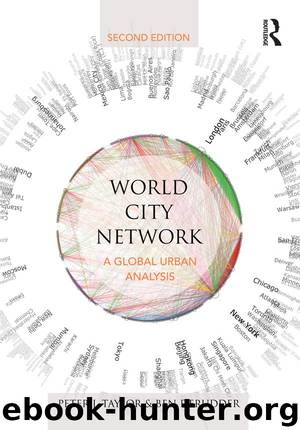World City Network by Taylor Peter J. & Derudder Ben

Author:Taylor, Peter J. & Derudder, Ben
Language: eng
Format: epub
ISBN: 9781317550525
Publisher: Taylor and Francis
Published: 2015-08-16T16:00:00+00:00
Measuring hinterworlds
To compute a city’s hinterworld it is necessary to specify its external relations with all other cities. For this exercise we deal with our operational roster of 152 world cities with at least one fifth of the connectivity of London. In principle, the hinterworld of a given city is simply a representation of its connectivity with every other city. But these initial city-dyad measures have limited utility for comparing urban hinterworlds. The basic problem can easily be seen in Table 4.2: London and Paris appear with very strong inter-city relations for all of the other cities, just as Boston and Maputo provide uniformly low levels of city-dyad connectivities. This is obviously reflecting the network position of these cities. Extrapolating this result to the entire data set, it is found that every city has its strongest connection with either London or New York.
In general, the problem is that city-dyad connectivities tend to closely follow the level of global network connectivities of the cities involved. This means that simply mapping hinterworlds based on city-dyad connectivity measures would produce results that largely replicate the global network connectivity distribution: all hinterworlds, although not exactly the same, look quite similar. Small differences are discernible: in the pedagogic example in Chapter 4 (pp. 61–2), Shanghai is more strongly connected with Chicago than with Paris in spite of the latter having a larger global network connectivity. Nonetheless, intense scrutiny of absolute hinterlands is not the sensible way forward here.
What is required is a measure of hinterworlds from which the global network connectivity of cities is removed. This is actually a relatively simple task. Scatter diagrams of city-dyad connectivity scores against global network connectivity scores show imperfect, yet strong positive linear relationships in every case. Thus city a’s connections can be regressed against the global network connectivity of the other 151 cities using a simple regression equation:
Download
This site does not store any files on its server. We only index and link to content provided by other sites. Please contact the content providers to delete copyright contents if any and email us, we'll remove relevant links or contents immediately.
Kotlin in Action by Dmitry Jemerov(17250)
Grails in Action by Glen Smith Peter Ledbrook(15436)
Sass and Compass in Action by Wynn Netherland Nathan Weizenbaum Chris Eppstein Brandon Mathis(13293)
Azure Containers Explained by Wesley Haakman & Richard Hooper(7500)
Configuring Windows Server Hybrid Advanced Services Exam Ref AZ-801 by Chris Gill(7497)
Running Windows Containers on AWS by Marcio Morales(7054)
Microsoft 365 Identity and Services Exam Guide MS-100 by Aaron Guilmette(5436)
Microsoft Cybersecurity Architect Exam Ref SC-100 by Dwayne Natwick(5275)
Combating Crime on the Dark Web by Nearchos Nearchou(5018)
The Ruby Workshop by Akshat Paul Peter Philips Dániel Szabó and Cheyne Wallace(4701)
Management Strategies for the Cloud Revolution: How Cloud Computing Is Transforming Business and Why You Can't Afford to Be Left Behind by Charles Babcock(4550)
Python for Security and Networking - Third Edition by José Manuel Ortega(4274)
The Age of Surveillance Capitalism by Shoshana Zuboff(4253)
Learn Wireshark by Lisa Bock(4176)
Learn Windows PowerShell in a Month of Lunches by Don Jones(4073)
The Ultimate Docker Container Book by Schenker Gabriel N.;(3920)
Ember.js in Action by Joachim Haagen Skeie(3670)
DevSecOps in Practice with VMware Tanzu by Parth Pandit & Robert Hardt(3612)
Windows Ransomware Detection and Protection by Marius Sandbu(3579)
